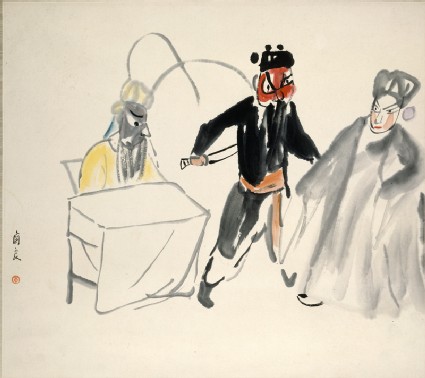Chinese Paintings in the Ashmolean Museum, Oxford
A catalogue of the Ashmolean collection of Chinese paintings by Shelagh Vainker (published Oxford, 2000).

Publications online: 222 objects
Scene from The Execution of Chen Shimei
-
Literature notes
Guan Ling was born in Panyu, Guangdong province, and studied in Japan between 1917 and 1922. On his return he taught at several art colleges across southern China, and introduced Western methods with which he had become acquainted while abroad. After 1949 he served on the committees of several artists' associations. He frequently painted in oils; in ink he is particularly well-known for his paintings of opera figures. -
Description
The Execution of Chen Shimei is one of the most famous fictionalised law cases, adjudicated by a highly-respected official of the Northern Song dynasty, Bao Zheng (AD 999-1062), who later became a symbol of justice. Adapted into novels and dramas, the story has enjoyed sustained popularity.
The white-faced scholar in this painting, Chen Shimei (right), betrayed his wife Qin Xianglian by marrying the emperor’s daughter in order to better his career after passing his imperial examination. As son-in-law of the emperor, he then wanted to murder Xianglian. The black-faced official seen sitting at a desk, Judge Bao (left), however, did not surrender to the pressure from the queen and princess. With the help of his faithful, red-faced assistant Zhan Zhao (centre), an expert in martial arts, Judge Bao executed Chen Shimei and saved Xianglian’s life.
Guan Liang was born in Guangzhou but spent his career in Shanghai. In his early years, he studied oil painting in Japan, and also came to admire the work of the Impressionists. He is best known for his ink painting of theatrical scenes.
-
Details
- Associated place
- Date
- 1935 - 1968
- Artist/maker
-
Guan Liang (1900 - 1986) (artist)
- Associated people
-
Bao Zheng (AD 999 - 1062) (subject)
- Material and technique
- ink and colour on paper
- Dimensions
-
mount 148 x 51.5 cm (height x width)
painting 34.5 x 38.5 cm (height x width)
along roller 59 cm (length)
- Material index
- Technique index
- Object type index
- No. of items
- 1
- Credit line
- Purchased, 1968.
- Accession no.
- EA1968.74
-
Further reading
Vainker, Shelagh, Chinese Paintings in the Ashmolean Museum, Oxford (Oxford: Ashmolean Museum, 2000), no. 32 on p. 56, illus. p. 56 fig. 32
Past Exhibition
see (1)Location
-
- currently in research collection
Objects are sometimes moved to a different location. Our object location data is usually updated on a monthly basis. Contact the Jameel Study Centre if you are planning to visit the museum to see a particular object on display, or would like to arrange an appointment to see an object in our reserve collections.
Publications online
-

Chinese Paintings in the Ashmolean Museum, Oxford
Guan Ling was born in Panyu, Guangdong province, and studied in Japan between 1917 and 1922. On his return he taught at several art colleges across southern China, and introduced Western methods with which he had become acquainted while abroad. After 1949 he served on the committees of several artists' associations. He frequently painted in oils; in ink he is particularly well-known for his paintings of opera figures.
Notice
Object information may not accurately reflect the actual contents of the original publication, since our online objects contain current information held in our collections database. Click on 'buy this publication' to purchase printed versions of our online publications, where available, or contact the Jameel Study Centre to arrange access to books on our collections that are now out of print.
© 2013 University of Oxford - Ashmolean Museum


